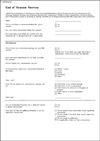Sport-Related Concussion Reporting and State Legislative Effects
- PMID: 25894530
- PMCID: PMC4609217
- DOI: 10.1097/JSM.0000000000000192
Sport-Related Concussion Reporting and State Legislative Effects
Abstract
Objective: To investigate concussion rates and reporting frequencies in high school and collegiate athletes in 2013, compare results to those obtained from 1999 to 2002, and examine to what extent the 2012 Wisconsin state concussion law affected reporting in 2013.
Design: Retrospective 2013 survey compared with prior survey.
Setting: High schools and colleges in the Milwaukee, Wisconsin, area.
Participants: Athletes (N = 784) from multiple sports were surveyed in 2013. Football players (N = 1532) from 1999 to 2002 completed the same measure.
Main outcome measures: Both surveys assessed concussion history, concussion incidence during the current season, whether incident concussions were reported, who concussions were reported to, and reasons for not reporting. The 2013 survey also assessed awareness of the Wisconsin state law and its effect on reporting.
Results: Rates of concussion in the surveyed season were comparable to previous findings from 1999 to 2002 (16.6% vs 15.3%, P = 0.558). Notably, athletes were significantly more likely to report their concussions in 2013 (70.6% vs 47.3% previously, P = 0.011). Among high school athletes surveyed, 59.5% were aware of the Wisconsin state law, with 55.1% stating it would make them more likely to report a concussion.
Conclusions: Rates of concussion for 1 sport season have not changed significantly over the past 14 years. The percentage of concussions that are reported to someone has increased significantly. Awareness of the Wisconsin state law does not fully account for the increase in concussion reporting.
Clinical relevance: Given the finite amount of knowledge regarding the influence of concussion-related cultural and legal changes, these findings will help to inform clinicians of the current concussion milieu from the perspective of athletes. It will inform practitioners involved in concussion management to what extent athletes are aware of and report concussions.
Comment in
-
In Response to: Sport-Related Concussion Reporting and State Legislative Effects.Clin J Sport Med. 2016 Jan;26(1):e7. doi: 10.1097/JSM.0000000000000233. Clin J Sport Med. 2016. PMID: 26679210 No abstract available.
References
-
- McCrea M, Hammeke T, Olsen G, et al. Unreported concussion in high school football players: implications for prevention. Clin J Sport Med. 2004;14:13–17. - PubMed
-
- Kerr ZY, Marshall SW, Harding HP, Jr, et al. Nine-year risk of depression diagnosis increases with increasing self-reported concussions in retired professional football players. Am J Sport Med. 2012;40:2206–2212. - PubMed
-
- Tator CH. Chronic traumatic encephalopathy: how serious a sports problem is it? Br J Sports Med. 2014;48:81–83. - PubMed
-
- McCrea M, Guskiewicz KM, Marshall SW, et al. Acute effects and recovery time following concussion in collegiate football players: the NCAA Concussion Study. JAMA. 2003;290:2556–2563. - PubMed
-
- Nelson LD, Janecek JK, McCrea MA. Acute clinical recovery from sport-related concussion. Neuropsychol Rev. 2013;23:285–299. - PubMed
Publication types
MeSH terms
Grants and funding
LinkOut - more resources
Full Text Sources
Other Literature Sources
Medical
Miscellaneous


